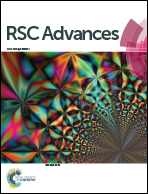1,2,3-Triazole-fused spirochromenes as potential anti-tubercular agents: synthesis and biological evaluation†
Abstract
A facile and convenient approach has been designed for the synthesis of novel prototypes that possess the advantage of the two pharmacophores of chromene and 1,2,3-triazole in a single molecular backbone, were evaluated against Mycobacterium tuberculosis H37Rv strain. The new analogues 1,2,3-triazole-fused spirochromenes were accomplished in four step synthetic strategy utilizing click chemistry ([3 + 2] Huisgen cycloaddition) in the ultimate step. The synthesized compounds were established based on the spectral data and X-ray crystal structure for 7a. Among the compounds tested against Mycobacterium tuberculosis H37Rv strain, some products exhibited potent antimycobacterial activity with minimum inhibitory concentration (MIC) values ranging from 1.56 to 6.25 μg mL−1. Compounds exhibiting good in vitro potency in the MTB MIC assay were further examined for cytotoxicity in a RAW 264.7 cells. Compounds 7a, 7d, 7i (MIC: 1.56 μg mL−1) and 7k, 7m (MIC: 3.125 μg mL−1) exhibited promising hits.



 Please wait while we load your content...
Please wait while we load your content...